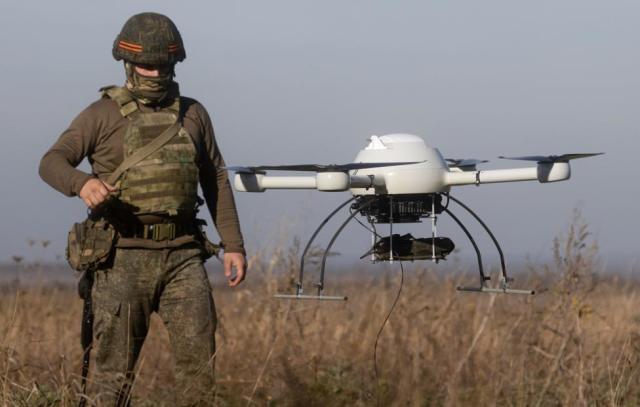TASS — about the bright unmanned novelties of the international military-technical forum
Revolutionary weapons
It is obvious that at present unmanned aerial vehicles (UAVs) are making another revolution on the battlefield, just as many years ago it was only the planes and tanks that appeared. Therefore, it is not surprising that every year more and more drone manufacturers participate in the largest arms exhibition — the Army forum in the Patriot Park near Moscow. Moreover, not only the number of devices presented at the exposition is growing, but the scope of their application is also expanding. Today, this is primarily facilitated by a special military operation in Ukraine. If at its very beginning the domestic unmanned fleet consisted mainly of "Eagles" and "Lancets", today squadrons of new UAVs of domestic development are sent to the front, which are capable of observing, guarding and delivering precision strikes with a wide range of ammunition. In the shortest possible time, the Russian defense industry managed to master an absolutely new direction — the production of combat FPV drones (first-person view, "first-person view"), almost invulnerable, hitting the enemy with sniper accuracy.
The number of high-tech novelties created to protect our troops from enemy UAVs is also growing. The most successful Russian anti-drones are already undergoing "training" in a special military operation.
Stormtroopers-scouts
They did not become fighting immediately. At first, they were used for sports and shooting action movies, when it was necessary to make the viewer literally dizzy. Today, FPV drones are a formidable weapon capable of maneuvering at a speed of 200 km / h, flying into vents and vents, diving with a charge at any, even a fast—moving target. One of the main novelties in this direction of drone engineering at the Army-2023 forum was presented by the Astron Optical and Mechanical Design Bureau (OKB) of the Shvabe Holding (part of the Rostec state Corporation, unites several dozen research centers in 10 cities of Russia).
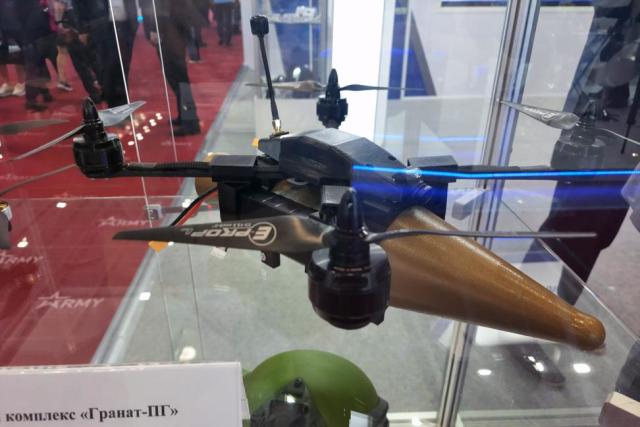 |
| FPV drone "Garnet-PG". |
| Source: Vasily Kuchushev/ TASS |
There are four main developments of the Design Bureau at the Astron stand: two of them are the Kurs—800 TB reconnaissance and strike UAVs operating in the mode of conventional UAVs, two more FPV drones with cumulative fragmentation combat elements "Garnet-KOBE".
"The Astron Design Bureau company produces FPV drones, they are kamikaze drones, for various payloads. These can be PG-7 grenades (shot from a hand—held anti-tank grenade launcher (RPG) - approx. TASS), as well as cumulative fragmentation ammunition weighing from 500 g. Also, suspensions for a cassette of four cumulative ammunition can be used on our combat drones," Vitaly Serov, chief designer of the Astron Design Bureau, said in an interview with TASS.
According to Vitaly Serov, the Astron drones have already been sent to the SVO zone and are being successfully used by four Russian units. At the same time, the developer notes that today Russian enterprises have the opportunity to produce not only FPV drones, but also special glasses for flight control, which at the dawn of the development of FPV technologies had to be purchased abroad. "Our helmets and goggles have been tested on the basis of the Novosibirsk Higher Military School and are ready for mass production. As for the general training of military personnel to work with FPV drones, there are no problems here. Our company has the relevant experience and personnel. In addition, for the speed of mastering this type of weapon, we have specially simplified the controls so that any serviceman could master this technique right at the front in three to five days," said the chief designer of Astron.
The company's FPV drones, like many other flying kamikazes, are devoid of many traditional UAV devices, such as, for example, a navigator and an air position sensor. The Kurs scouts, on the contrary, are literally stuffed with modern equipment. Each, among other things, has a thermal imaging channel for round-the-clock search, detection, recognition and determination of the coordinates of targets. The height of the scout's flight is up to 3 km, the range is up to 5 km. The range of recognition of enemy manpower is up to 350 m during the day, up to 400 m at night. The detection range of the equipment is up to 800 m.
"Quasi-mast"
To transmit a radio signal in difficult geographical conditions, to see approaching saboteurs in the night or to detect an enemy drone — all this can be done by the newest Russian drone called "Quasi-Mast", created by the Kalashnikov concern and the YVS Avia company.
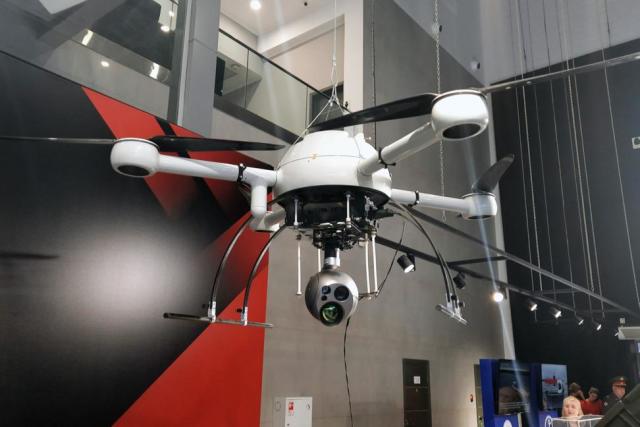 |
| The lifting system of the equipment "Quasi-mast". |
| Source: Vasily Kuchushev/ TASS |
"Quasi—mast" is a system of lifting equipment. Its main purpose is the retransmission of a radio signal. For example, if you need to transmit a signal from one point to another, but there is a mountain or other obstacle in the way, a "quasi—mast" with attachments attached to it will help you get around it," Roman Bartagov, a design technician at the YVS Avia enterprise, told TASS. According to him, the device cannot be called a classic drone, since the "Quasi-Mast" is on a leash all the time during its operation. The power is supplied via a special cable, due to which the quadcopter is able to take off to a height of up to 100 m and work without stopping for more than 24 hours.
"Also, the "Quasi-mast" with the help of a camera can observe the perimeter, including in the infrared range. If you hang four such UAVs on an area of a square kilometer, then you will have a view of the entire territory," says Roman Bartagov.
The "quasi-mast" has already proven itself well in its own, but the front, as the developers say, is not the only place where the device can be useful. "The device is equipped with a thermal imager and can be successfully used in the Ministry of Emergency Situations for radiation monitoring and prevention of environmental disasters. In addition, the model without tethered power supply can be used as a means of sensing the Earth's surface," concludes the representative of the developer company.
"Roadblock"
Drones are a universal weapon that can be used both separately and as part of special complexes, such as "Checkpoint-4T". Astron engineers presented at Army-2023 a complex of long-range thermal imaging intelligence with intelligent analytics, which allows detecting various targets at a distance of several kilometers.
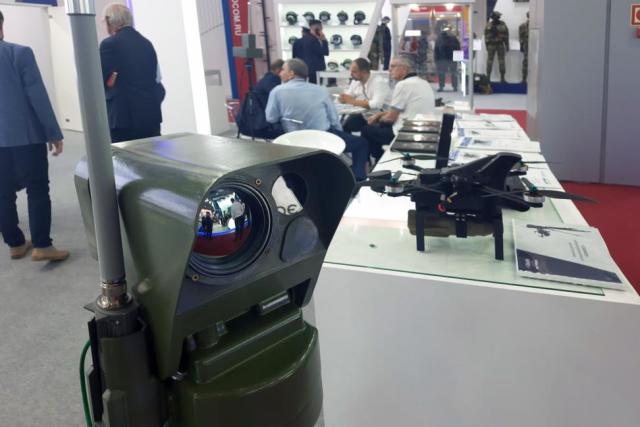 |
| The Checkpoint-4T complex. |
| Source: © Vasily Kuchushev/ TASS |
"Currently, the Russian army is armed with various optoelectronic means of collecting information about the terrain in all weather conditions, including thermal imaging. At the same time, there is always a dilemma for both optical and thermal imaging devices — either you have a large field of view, or you provide high image detail. <...> We thought that integrating a flying thermal imager into a ground—based surveillance system would allow us to solve this dilemma in a non-standard and rather elegant way," Vladimir Popov, General Director of the Astron Design Bureau, told TASS earlier in an interview.
As previously reported by TASS, the long-range reconnaissance complex has a single control system and image reception with its output to a single monitor. "Ground thermal imaging stations of the Checkpoint-4T complex allow detecting people at a distance of up to 800 m and cars at a distance of up to 2 thousand m. Built-in video analytics highlights detected objects on the screen to help the operator. Next, the operator sends a drone to the desired point. The recognition of detected targets is carried out by an unmanned thermal imaging system at a distance of up to 6 km," the CEO of the Astron Design Bureau said in an interview.
The complex of long—range thermal imaging can be placed anywhere - from the top of the tree to the hill. At the same time, the operator is in hiding, which is very important in the realities of modern warfare. The operator can be connected to the repeater by cable, thus becoming invisible to the enemy's electronic warfare means.
At the Army-2023 forum, it became known that the Checkpoint has passed all the necessary tests and is ready for mass production.
Anti-drone "Sickle"
Russian engineers pay no less attention to the production of anti-drones than to the creation of new UAVs. In 2023, at the Army forum, the Rostec State Corporation's Roselectronics holding presented the development of a line of the latest complexes for combating unmanned aerial vehicles "Sickle-VS-6".
 |
| The complex "Sickle-VS-6". |
| Source: Vasily Kuchushev/ TASS |
The device developed by the Vector Research Institute (part of the Roselectronics holding) is capable of suppressing the control channel of the drone, severing communication with the operator, disabling the navigation equipment of the UAV, thus disrupting the execution of the flight task. "Sickle" can jam GPS, GLONASS, Beidou signals and disrupt drone control over Wi-Fi.
The viewing strip of the Sickle-VS-6 complex is divided into four 90-degree sectors. The complex can simultaneously jam several channels within a radius of 5 km and protect objects from attacks by several UAVs at once, including those flying from different directions. The operating ranges from 430 MHz to 5.8 GHz make it possible to fight not only with civilian drones, but also with special-purpose drones.
"A distinctive feature of the new "Sickle" is working both in directional mode and in a 360—degree circular mode. The device has four panels on which there are transmitting antennas operating in different bands. You can either include all of them, or choose one to work in a specific range, in a single drone," Vladmir Duboysky, scientific director of the Sickle project at the Vector Research Institute, said in an interview with TASS.
According to Duboisky, the device is part of the Protection UAV detection and suppression system, which, in addition to the Sickle, includes a semi-active radar and a radio monitoring station. The work of the "Protection" begins immediately after the target is detected by the locator. Then the radio monitoring devices register the frequencies at which the UAV operates, detect control channels, after which the "Sickle" activates the range necessary for suppression. At the same time, the system is capable of operating both in semi-automatic mode in conjunction with the operator, and completely offline.
Hybrid UAV with all-terrain vehicle
Among the exhibits of the Army-2023 forum, there are unusual drones, such as a model with the digital designation "421-24" from Aeroscan. The developers have not yet decided what to call this device, but its future tasks have already been determined. The robotic platform will work in tandem with a drone that can act as a scout and navigator at the same time.
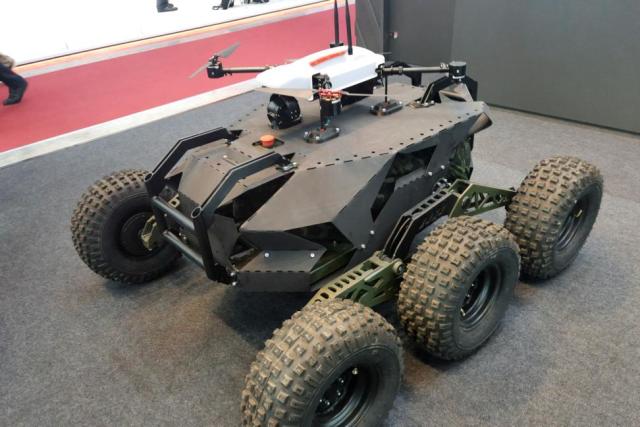 |
| Robotic platform with UAV "421-24". |
| Source: Vasily Kuchushev/ TASS |
According to the developers, if necessary, a machine gun or, for example, scientific equipment can be installed on the platform. The robot can also be equipped with stretchers to evacuate the wounded from the battlefield.
Vasily Kuchushev
